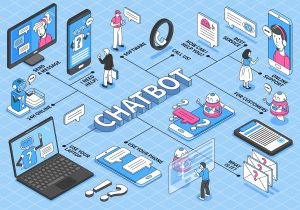Introduction
Throughout several industries, the increase of chatbots, from instruction to finance, is transforming the way we interact with technology. Artificial intelligence-powered chatbots imitate human conversation and provide a quick method for receiving information or performing a service. Although they have caused concerns regarding security and personal information safety. You’ll learn the essentials of creating a chatbot if you read this manual from start to finish.
Understanding Chatbots
A computer program utilizing AI that can imitate human conversations. Chatbots’ idea can be traced back to the 1960s, wherein MIT professor Joseph Weizenbaum introduced Eliza, the first chatbot ever, to replicate human discussions with predetermined responses. Throughout history, chatbots have made substantial progress towards complex conversation.
Chatbots Approaches
There are two primary approaches to developing chatbots: the machine learning algorithms or methods.
Pattern Matching Approaches:
Chatbots employing pattern matching use rule-based methods to link input from users and predefined responses. They have decision-based conversations, but without AI. Rule-based chatbots can generate original dialogue and surprise the user by doing so.
Machine Learning Approach:
Chatbots using ML apply NLP to retrieve data from user input. An artificial neural network and an enhanced ability to carry out a discussion are utilized to produce better results for tough questions.

Use Cases of Chatbots
Chatbots find applications in various industries, and some common use cases include:
Education:
Educational institutions employ chatbots to support students in getting advice on their studies and to handle administrative work. By using an AI chatbot, colleges may handle student questions more rapidly and automate enrollment procedures.
Customer Service:
Chatbots help businesses offer constant consumer care, providing rapid replies to questions from customers and boosting user experience.
Health:
AI-driven chatbots facilitate patient communication by providing rapid answers.
Banking:
A chatbot can give basic information about bank

E-Commerce:
Online shopping platforms employ chatbots to aid clients by offering product information, questions, and orders tracking details. Enhanced customer assistance is a result.
Human Resource:
HR chatbots facilitate workforce growth by overseeing the hiring process, initial training, and staff oversight.
Hospitality:
Bots can aid people working in hotels by managing reservations and organizing travel plans
Chatbot privacy and security difficulties
The widespread use of chatbots raises several privacy and security concerns, including:
Data Protection:
Users could unwittingly share private information when chatting with chatbots. Designing chatbots may make compliance with privacy laws difficult.

Non-encrypted Conversation:
Some chatbot communications can be accessed by unauthorized individuals or even hackers.
Identity Confirmation:
Some chatbots fail to correctly authenticate identities which may result in confidential information disclosure.
Exposure to Data Breaches:
Data may be subjected to compromise if chatting with chatbots that link up with external sources.
Malicious Attacks:
Evil bots take advantage of humans by requesting that they expose private facts about themselves, which will be utilized to open their bank accounts or launch attacks through them.
Lack of Algorithmic Transparency:
Keeping algorithmic particulars and knowledge bases under wraps is a normal occurrence among chatbot builders.

Steps to take when protecting private and safety
To address privacy and security vulnerabilities in chatbots, consider the following recommendations:
Comply with Data Protection Laws:
Businesses implementing chatbots need to stick to data protection regulations and include privacy principles in their design cycles.
Implement User Identity Authentication:
Chatbot identifications are required to prevent phishing.
Educate the Public:
Help everyone better utilize and understand cybersecurity, with chatbots as a tool.
Use Encryption and Authentication Protocols:
Encode chatbot information using authentication measures to safeguard it.
Use Self-Destructing Messages:
Erase critical data utilizing encrypted SMS messages that automatically delete themselves after being read.

Provide Clear Privacy Notices:
Be certain that chatbots present unambiguous terms of usage and privacy notices and acquire consumer consent to maintain legality.
Conclusion
Chatbots have advanced across multiple industries and provide users with speedy access to facts and facilities. One thing is that … Through best practices implementation, following data protection regulations, and encouraging digital awareness, chatbot makers can foster a safe and secure customer experience. It is essential to maintain vigilance and proactivity when confronting security and privacy concerns for chatbots as technological progress continues.



